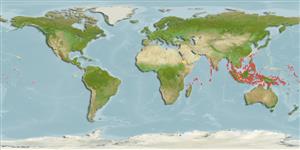Common names from other countries
>
Eupercaria/misc (Various families in series Eupercaria) >
Scaridae (Parrotfishes) > Scarinae
Etymology: Scarus: Greek, skaros = a fish described by anciente writers as a parrot fish; 1601 (Ref. 45335).
More on author: Valenciennes.
Environment: milieu / climate zone / depth range / distribution range
Ecologia
marinhas associadas(os) a recifes; intervalo de profundidade 1 - 25 m (Ref. 90102). Tropical; 30°N - 13°S
Indo-West Pacific: Maldives to New Ireland in Papua New Guinea, including Cocos-Keeling Islands, north to Ryukyu Islands and south to the Philippines, including Palau. This species is the terminal male of Scarus singaporensis. Possibly replaced by Scarus falcipinnis in the western Indian Ocean (Ref. 2689).
Tamanho / Peso / Idade
Maturity: Lm ? range ? - ? cm
Max length : 70.0 cm TL macho/indeterminado; (Ref. 9710)
Espinhos dorsais (total): 9; Raios dorsais moles (total): 10; Espinhos anais 3; Raios anais moles: 9. Scales large. Median predorsal scales 6; 3 scale rows on cheek, with 1-3 scales in ventral row. Caudal fins emarginate in initial phase to deeply concave in large terminal phase. Lips nearly covering dental plates; terminal males with 0-2 canines posteriorly on side of upper plate, none on lower. The initial phase closely resembles that of S. altipinnis (Ref. 1602). The terminal phase has the distinctive brilliant green throat and lacks the filamentous middle dorsal spine (Ref. 1602).
Found in seaward slopes and reef flats (Ref. 90102). Usually associated with outer reefs but will enter shallow water in protected areas. Often in large schools (Ref. 9710). Grazes on benthic algae (Ref. 3488). Also caught with nets and other types of artisanal gear (Ref. 2689). Minimum depth of 1 m reported from Ref. 30874.
Life cycle and mating behavior
Maturidade | Reprodução | Desova | Ovos | Fecundidade | Larvas
Oviparous, distinct pairing during breeding (Ref. 205).
Randall, J.E. and J.H. Choat, 1980. Two new parrotfishes of the genus Scarus from the Central and South Pacific, with further examples of sexual dichromatism. Zool. J. Linn. Soc. 70:383-419. (Ref. 2689)
Categoria na Lista Vermelha da IUCN (Ref. 130435)
CITES (Ref. 128078)
Not Evaluated
Ameaça para o homem
Harmless
Utilização humana
Pescarias: espécies comerciais; Aquário: Espécies comerciais
Mais informação
ReferênciasAquaculturaPerfil para aquaculturaEstirpesGenéticaElectrophoresesHereditariedadeDoençasProcessamentoMass conversion
Ferramentas
Relatórios especiais
Descarregue XML
Fontes da internet
Estimates based on models
Preferred temperature (Ref.
115969): 26.1 - 29.3, mean 28.7 (based on 2454 cells).
Phylogenetic diversity index (Ref.
82804): PD
50 = 0.5000 [Uniqueness, from 0.5 = low to 2.0 = high].
Bayesian length-weight: a=0.01023 (0.00436 - 0.02401), b=3.09 (2.90 - 3.28), in cm Total Length, based on LWR estimates for this Genus-body shape (Ref.
93245).
Nível Trófico (Ref.
69278): 2.0 ±0.0 se; based on diet studies.
Resiliência (Ref.
120179): Médio, tempo mínimo de duplicação da população 1,4 - 4,4 anos (Preliminary K or Fecundity.).
Fishing Vulnerability (Ref.
59153): Moderate to high vulnerability (48 of 100).
